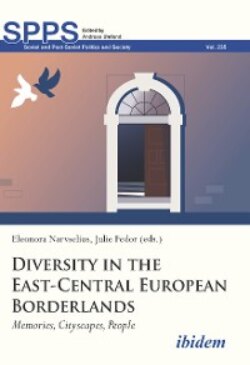Читать книгу Diversity in the East-Central European Borderlands - Группа авторов - Страница 21
На сайте Литреса книга снята с продажи.
Chernivtsi/Chernovtsy in the Postwar Soviet Period
ОглавлениеAfter the war, the Jewish National House was turned into a Soviet Palace of Culture. The Romanian National House, used by the SS in 1941, was taken over by the Red Army. The Greek Orthodox Cathedral was used for industrial and agricultural exhibitions and the Jesuit church as archives, both divided into several floors. The Metropolitan Palace was changed to a university and in 1959 the ruined Israeli Temple was re-purposed as a cinema.
Soviet street names and memorials replaced the old ones.50 Strada Iancu Flondor (Herrengasse) was renamed after the local Ukrainian writer Olha Kobylyans’ka, whose monument replaced the previous statue of Mihai Eminescu,51 in front of the Municipal Theater, also now renamed after Kobylyans’ka.
Figure 2.6. Chernivtsi. Buildings, users, and inhabitants at Piaţa Unirii (Austrian Ringplatz, present-day Ploshcha Tsentral’na), Strada Bucureştilor (Austrian Postgasse, present-day Vulytsya Khudyakova), and the southern part of Strada Regele Ferdinand (Austrian Enzenberg Haupt-strasse, present-day Holovna vulytsya) in 1936 and earlier. Dark grey: preserved buildings. Buildings that have not been preserved are marked light grey. Map by the author, based on material from the municipal archive (1940) and from the digitalized address book (1936), available at czernowitz.blogspot.com/2010/02/address-book-for-czernowitz-for-yeare.html, as well as old photos in several books.
Wartime destruction was limited to small areas, north of the central square, partly replaced by a space for political placards and posters and later by a memorial to Taras Shevchenko. “Socialist Realist” buildings were erected opposite the former Temple and the Post Street, rather well adapted to the location. Most old buildings were preserved as useful to the newcomers after the war. Soviet planning focused on city expansion towards the south, leaving the old city center in peace, but somewhat neglected. Important city institutions remained there, such as the university, the City Theater, the Town Hall and the main corso, Kobylyans’ka Street. In 1965, some proposed street widening would have eliminated several buildings, among them the former Musikverein. Luckily enough, this plan was not implemented.
During the perestroika era, a thorough inventory of buildings in the historical city center began, classified in relation to their architectural and historical significance. A great deal of attention was paid to the Austrian heritage of the “upper town,” less to the “lower town” and the Romanian heritage. The inventory was strictly architectural, paying little attention to social and historical aspects.
